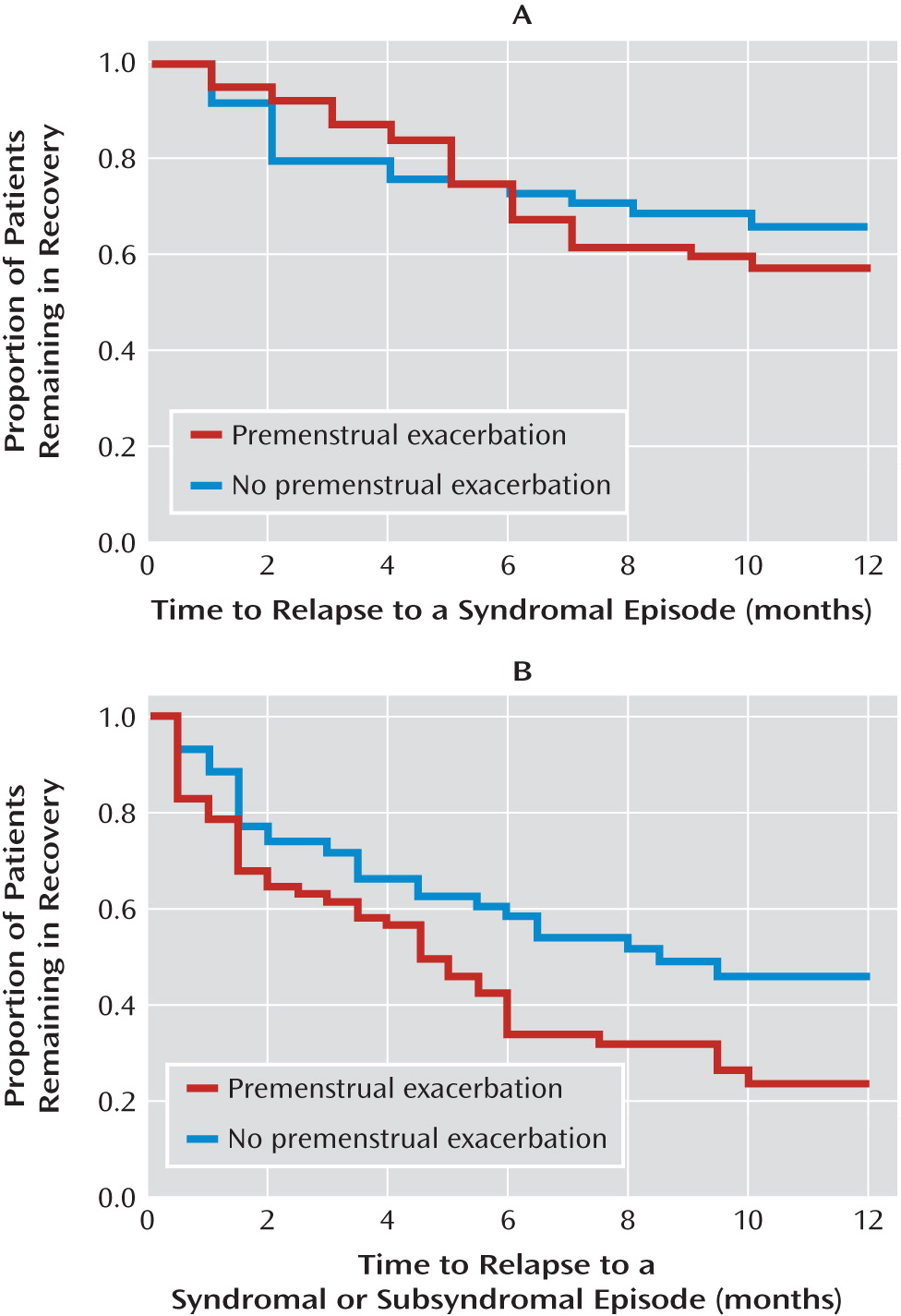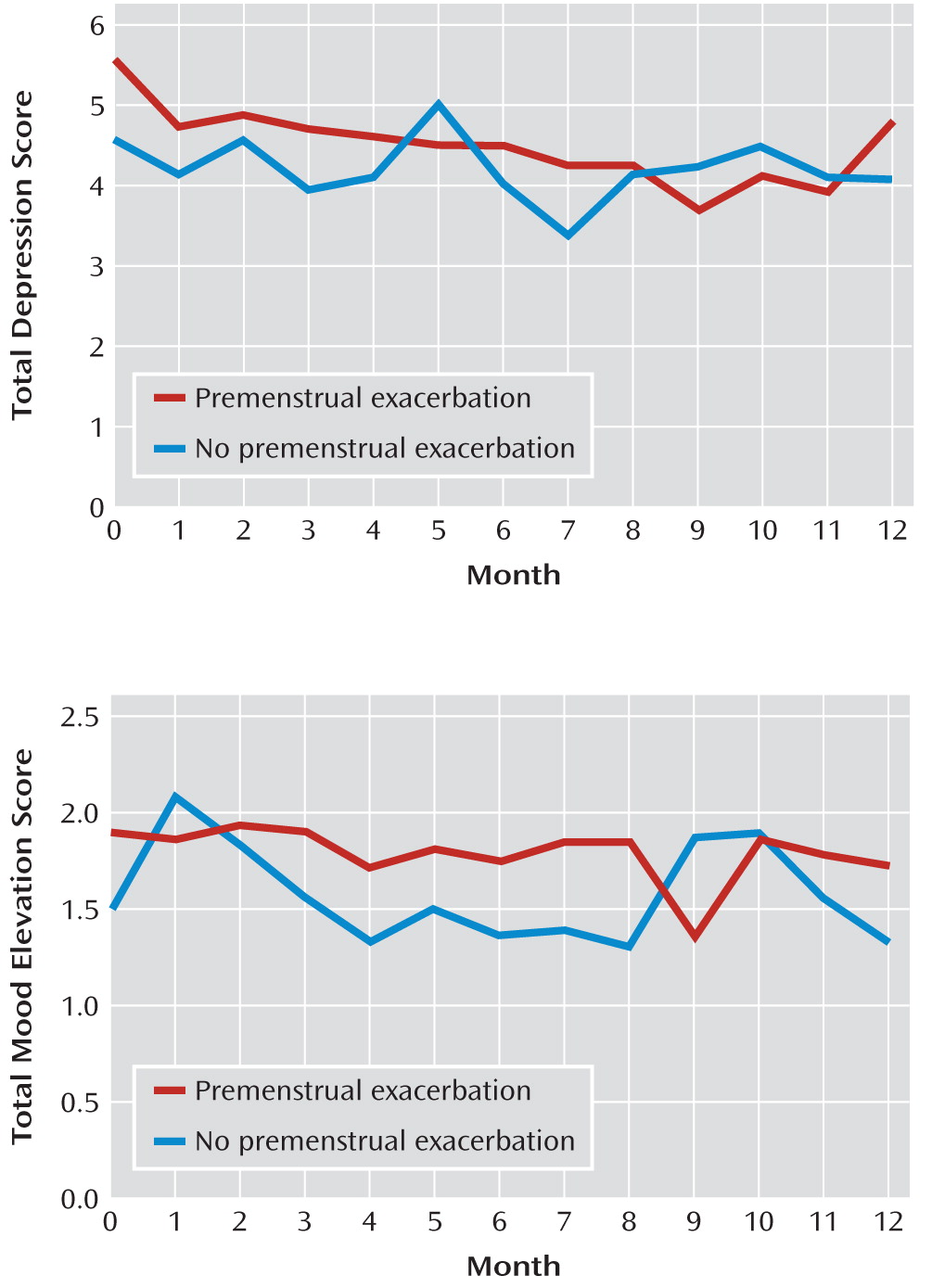Longitudinal Follow-Up of Bipolar Disorder in Women With Premenstrual Exacerbation: Findings From STEP-BD
Abstract
Objective:
Method:
Results:
Conclusions:
Method
Participants
Procedures
Analysis
Approvals
Results
| Followed for 1 Year (N=293) | Recovered at Baseline (N=129) | ||||||||||
|---|---|---|---|---|---|---|---|---|---|---|---|
| Characteristic | Premenstrual Exacerbation (N=191) | No Premenstrual Exacerbation (N=102) | p | Premenstrual Exacerbation (N=66) | No Premenstrual Exacerbation (N=63) | p | |||||
| N | % | N | % | N | % | N | % | ||||
| Caucasian | 181 | 94.8 | 91 | 89.2 | 0.08 | 60 | 90.9 | 54 | 85.7 | 0.36 | |
| High school diploma or higher | 185 | 97.4 | 100 | 98.0 | 0.72 | 64 | 97.0 | 62 | 98.4 | 0.59 | |
| Married or living as married | 68 | 35.6 | 32 | 31.4 | 0.48 | 25 | 37.9 | 22 | 34.9 | 0.72 | |
| Employed full-time | 94 | 49.5 | 107 | 50.5 | 0.51 | 40 | 60.6 | 36 | 58.1 | 0.77 | |
| Bipolar classification | 0.86 | 0.87 | |||||||||
| Bipolar I disorder | 114 | 59.7 | 64 | 62.7 | 38 | 57.6 | 39 | 61.9 | |||
| Bipolar II disorder | 63 | 33.0 | 32 | 31.4 | 24 | 36.4 | 21 | 33.3 | |||
| Bipolar disorder not otherwise specified | 13 | 6.8 | 5 | 4.9 | 4 | 6.1 | 3 | 4.8 | |||
| Schizoaffective disorder, bipolar type | 1 | 0.5 | 1 | 1.0 | 0 | 0.0 | 0 | 0.0 | |||
| Median | IQR | Median | IQR | Median | IQR | Median | IQR | ||||
| Age at enrollment (years) | 30.0 | 25.0–36.0 | 29.5 | 25.0–35.0 | 0.80 | 31.0 | 25.8–36.3 | 29 | 24.0–36.0 | 0.60 | |
| Age at first episode (years) | 14 | 10–17 | 16 | 12–18 | 0.06 | 15 | 12.3–20 | 16 | 14–18–0 | 0.35 | |
| Episodes in past year | 3 | 2–8 | 2 | 1–5 | 0.01 | 2 | 1–4 | 2 | 1–2 | 0.03 | |
| Depression episodes | 2 | 1–3 | 1 | 1–2 | 0.01 | 1 | 0.8–2 | 1 | 0–2 | 0.50 | |
| Manic or hypomanic episodes | 1 | 1–4 | 1 | 0–3 | 0.05 | 1 | 0–2 | 1 | 0–1 | 0.07 | |
| Assessments during follow-up | 9 | 7–11 | 9 | 6.8–11.0 | 0.52 | 6 | 5–9 | 7 | 4–8 | 0.54 | |
| N | % | N | % | N | % | N | % | ||||
| Mood episodes in past year | 0.04 | 0.05 | |||||||||
| 0 | 9 | 4.7 | 10 | 9.8 | 8 | 15.4 | 12 | 21.1 | |||
| 1–3 | 94 | 49.2 | 59 | 57.8 | 29 | 55.8 | 39 | 68.4 | |||
| ≥4 | 88 | 46.1 | 33 | 32.4 | 15 | 28.8 | 6 | 10.5 | |||
| Clinical status at study entry | <0.01 | ||||||||||
| Recovered | 27 | 14.1 | 35 | 34.3 | |||||||
| Subthreshold | 75 | 39.3 | 31 | 30.4 | |||||||
| Depressed | 65 | 34.0 | 19 | 18.6 | |||||||
| Manic or hypomanic | 8 | 4.2 | 9 | 8.8 | |||||||
| Mixed | 16 | 8.4 | 8 | 7.8 | |||||||
| Psychiatric comorbidity | 99 | 54.1 | 47 | 46.5 | 0.22 | 38 | 60.3 | 45 | 71.4 | 0.19 | |
| Pharmacotherapy | |||||||||||
| Medication treatment for bipolar disorder | 161 | 84.7 | 92 | 90.2 | 0.19 | 60 | 90.9 | 59 | 93.7 | 0.56 | |
| Mood stabilizer or second-generation antipsychotic | 150 | 78.9 | 85 | 83.3 | 0.37 | 53 | 80.3 | 53 | 84.1 | 0.57 | |
| SSRI/SNRI | 45 | 23.7 | 41 | 40.2 | <0.01 | 26 | 39.4 | 30 | 47.6 | 0.35 | |
| Reproductive variables | |||||||||||
| Current irregular menstrual cycles | 54 | 28.3 | 22 | 21.6 | 0.21 | 19 | 28.8 | 16 | 25.4 | 0.67 | |
| Current use of hormonal contraceptives | 45 | 23.6 | 28 | 27.7 | 0.44 | 12 | 18.2 | 15 | 23.8 | 0.43 | |
Frequency of Mood Episodes During 1-Year Follow-Up
Survival Analysis
Time to Relapse as a Function of Premenstrual Exacerbation

Symptom Severity During Follow-Up as a Function of Premenstrual Exacerbation

Discussion
Patient Perspective
Acknowledgments
Footnote
Supplementary Material
- View/Download
- 12.21 KB
References
Information & Authors
Information
Published In
History
Authors
Funding Information
Metrics & Citations
Metrics
Citations
Export Citations
If you have the appropriate software installed, you can download article citation data to the citation manager of your choice. Simply select your manager software from the list below and click Download.
For more information or tips please see 'Downloading to a citation manager' in the Help menu.
View Options
View options
PDF/EPUB
View PDF/EPUBLogin options
Already a subscriber? Access your subscription through your login credentials or your institution for full access to this article.
Personal login Institutional Login Open Athens loginNot a subscriber?
PsychiatryOnline subscription options offer access to the DSM-5-TR® library, books, journals, CME, and patient resources. This all-in-one virtual library provides psychiatrists and mental health professionals with key resources for diagnosis, treatment, research, and professional development.
Need more help? PsychiatryOnline Customer Service may be reached by emailing [email protected] or by calling 800-368-5777 (in the U.S.) or 703-907-7322 (outside the U.S.).

